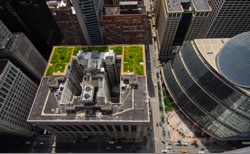
 March 4, 2009 — Green roofs are finally becoming a reality and are
March 4, 2009 — Green roofs are finally becoming a reality and are
increasingly being viewed as one of the responses to the challenges of
urban greening.
March 4, 2009 — Green roofs are finally becoming a reality and are increasingly being viewed as one of the responses to the challenges of urban greening. The following excerpt from the Green City Initiative, presented by Plant Publicity Holland managing director Jan Habets at the recent Landscape Ontario Congress, Canada’s largest horticultural trade show, discusses two cities that have embraced the concept.
Rotterdam is home to great examples of great green roof projects.
A city hastily rebuilt after suffering serious bombing damage in World War Two, the City of Rotterdam has seen its share of societal issues that are in large part attributable to poor urban design. It is particularly revealing, therefore, that this city, home to the second largest port in the world, would use Green City concepts as a tool for addressing social and economic problems, as well as providing green infrastructure solutions to address issues of the “urban heat island” and buffering of extreme rainfall to reduce flood risks.
Currently, the Water Management Department of Rotterdam is using green roofs to help control water levels. The economic benefits are so considerable that green roofs and roof gardens are now being promoted by the city in the form of tax breaks (something Germany has been doing for the past decade) and other subsidies because of the benefits they can deliver. In addition to improved air quality and enhanced biodiversity within the city, roof gardens and green roofs are delivering better water control, air quality and biodiversity benefits.
A few years ago, Chicago Mayor Richard Michael Daley declared his objective of making his city the greenest in the United States.
Not just interested in parks and trees, Mayor Daley is also committed to engaging in sustainable building in order to improve the quality of accommodation, working and living. To this end, “The Chicago Standard,” a new system of requirements that builders have to meet when designing, building and renovating public buildings, was established with the aim of saving on energy and management costs.
Almost simultaneously, he started a program that focuses on counteracting the city being a “heat island.” The pr ogram provides subsidies to parties prepared to build gardens and install greenery on roofs, so that less heat is absorbed and the temperature in the city is reduced.
ogram provides subsidies to parties prepared to build gardens and install greenery on roofs, so that less heat is absorbed and the temperature in the city is reduced.
Of course, one of the first green roof projects had to be the Mayor’s office at City Hall (see photo).
The Mayor’s office only occupies (and has jurisdiction over) half of the building. So when the green roof was installed, it only covered half of the building. This has turned out to be one of the most effective and compelling comparison standards for green roofs.
Not only does the green roof absorb 90 per cent of rainfall before gradually releasing it into the city’s storm water management system, on a summer day the average temperature on the green roof half is approximately 90°F (33°C), while on the non-green roof side it often reaches as high as 170° F (77°C).
With facts such as these, it is not surprising that green roof programs, materials and know-how are a fast-growing segment of the international horticultural industry.
Print this page